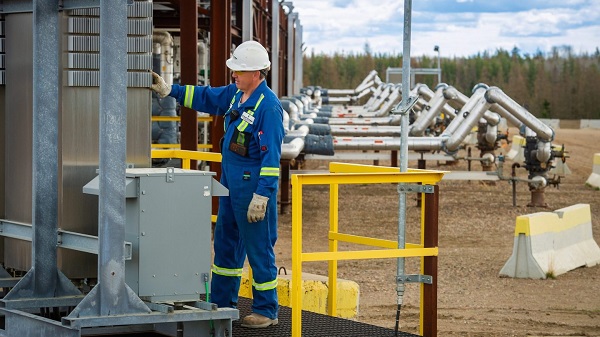Business
Ottawa foresees a future of despair for Canadians. And shrugs

This article supplied by Troy Media.
 By Lee Harding
By Lee Harding
A government report envisions Canadians foraging for food by 2040. Ottawa offers no solutions, just management of national decline
An obscure but disturbing federal report suggests Canadians could be foraging for food on public lands by 2040.
Policy Horizons Canada released the dire forecast on Jan. 7, 2025, in a report entitled Future Lives: Social Mobility in Question. It went largely unnoticed at the time, but its contents remain deeply concerning and worth closer examination.
Policy Horizons Canada is a little-known federal think-tank within the public service that produces long-term strategic foresight to guide government decision-making. Though not a household name, its projections can quietly shape policies at the highest levels. It describes itself as the government’s “centre of excellence in foresight,” designed to “empower the Government of Canada with a future-oriented mindset and outlook to strengthen decision making.” Its current head is Kristel Van der Elst, former head of strategic foresight at the World Economic Forum.
The report warns that the “powerful promise” that anyone can get an education, work hard, buy property and climb the social and economic ladder is slipping away. Instead of a temporary setback, the authors argue, downward mobility could become the norm. They liken Canada’s future to a board game with “more snakes than ladders.”
“In 2040, upward social mobility is almost unheard of in Canada,” the report states. “Hardly anyone believes that they can build a better life for themselves, or their children, through their own efforts. However, many worry about sliding down the social order.”
While these scenarios aren’t firm predictions, foresight reports like this are intended to outline plausible futures. The fact that federal bureaucrats see this as realistic is revealing—and troubling.
Post-secondary education, the report suggests, will lose its appeal. Rising costs, slow adaptation to labour market needs, long program durations and poor job prospects will push many away. It predicts that people will attend university more to join the “elite” than to find employment.
Home ownership will be out of reach for most, and inequality between those who own property and those who don’t will drive “social, economic, and political conflict.” Inheritance becomes the only reliable path to prosperity, while a new aristocracy begins to look down on the rest.
The gap between what youth are told to want and what they can realistically expect will widen, fuelling frustration and apathy. As automation and artificial intelligence expand, many traditional white-collar jobs will be replaced by machines or software. “Most people (will) rely on gig work and side hustles to meet their basic needs,” the report warns.
This leads to one of the darkest predictions: “People may start to hunt, fish, and forage on public lands and waterways without reference to regulations. Small scale agriculture could increase.”
The authors don’t propose solutions. Instead, they ask: “What actions could be taken now to maximize opportunities and lessen the challenges related to reduced and/or downward social mobility in the future?”
That question should concern us. Policymakers aren’t being asked how to prevent the collapse of social and economic mobility but how to manage its
fallout. Are those envisioning Canada’s future more interested in engineering a controlled implosion than fostering hope and opportunity?
Yes, artificial intelligence will bring challenges and change. But there is no excuse for despair in a country as rich in natural resources as Canada. Besides, the 2021 income data used in the report predates even the release of the first version of ChatGPT.
If policymakers are serious about restoring upward mobility, they must prioritize Canada’s resource economy. Ports, pipelines, oil and gas development, and mining are essential infrastructure for prosperity. When these sectors are strangled by overregulation, investment dries up—and so do jobs. The oil patch remains one of the fastest paths from poverty to wealth. Entry-level jobs in the field require training and safety courses, not four-year degrees.
Similarly, post-secondary education doesn’t need to be as expensive or time consuming as it is now. We should return to models where nurses could earn certification in two years instead of being funnelled into extended university programs. And if governments required universities to wind down defined benefit pension plans, tuition would fall fast.
Unfortunately, there’s a real risk that policymakers will use reports like this to justify more wealth-killing socialism. A home equity tax, for example, might be pitched to avoid future tensions between renters and homeowners. Such a tax would require Canadians to pay an annual levy based on the increased value of their home even if they haven’t sold it. These policies don’t build wealth—they punish it, offering temporary relief in place of lasting progress.
Unless we choose a more sensible path, the controlled demolition of Canada will continue.
Lee Harding is a research fellow for the Frontier Centre for Public Policy.
Troy Media empowers Canadian community news outlets by providing independent, insightful analysis and commentary. Our mission is to support local media in helping Canadians stay informed and engaged by delivering reliable content that strengthens community connections and deepens understanding across the country
Automotive
The high price of green virtue

By Jerome Gessaroli for Inside Policy
Reducing transportation emissions is a worthy goal, but policy must be guided by evidence, not ideology.
In the next few years, the average new vehicle in British Columbia could reach $80,000, not because of inflation, but largely because of provincial and federal climate policy. By forcing zero-emission-vehicle (ZEV) targets faster than the market can afford, both governments risk turning climate ambition into an affordability crisis.
EVs are part of the solution, but mandates that outpace market acceptance risk creating real-world challenges, ranging from cold-weather travel to sparse rural charging to the cost and inconvenience for drivers without home charging. As Victoria and Ottawa review their ZEV policies, the goal is to match ambition with evidence.
Introduced in 2019, BC’s mandate was meant to accelerate electrification and cut emissions from light-duty vehicles. In 2023, however, it became far more stringent, setting the most aggressive ZEV targets in North America. What began as a plan to boost ZEV adoption has now become policy orthodoxy. By 2030, automakers must ensure that 90 per cent of new light-duty vehicles sold in BC are zero-emission, regardless of what consumers want or can afford. The evidence suggests this approach is out of step with market realities.
The province isn’t alone in pursuing EV mandates, but its pace is unmatched. British Columbia, Quebec, and the federal government are the only ones in Canada with such rules. BC’s targets rise much faster than California’s, the jurisdiction that usually sets the bar on green-vehicle policy, though all have the same goal of making every new vehicle zero-emission by 2035.
According to Canadian Black Book, 2025 model EVs are about $17,800 more expensive than gas-powered vehicles. However, ever since Ottawa and BC removed EV purchase incentives, sales have fallen and have not yet recovered. Actual demand in BC sits near 16 per cent of new vehicle sales, well below the 26 per cent mandate for 2026. To close that gap, automakers may have to pay steep penalties or cut back on gas-vehicle sales to meet government goals.
The mandate also allows domestic automakers to meet their targets by purchasing credits from companies, such as Tesla, which hold surplus credits, transferring millions of dollars out of the country simply to comply with provincial rules. But even that workaround is not sustainable. As both federal and provincial mandates tighten, credit supplies will shrink and costs will rise, leaving automakers more likely to limit gas-vehicle sales.
It may be climate policy in intent, but in reality, it acts like a luxury tax on mobility. Higher new-vehicle prices are pushing consumers toward used cars, inflating second-hand prices, and keeping older, higher-emitting vehicles on the road longer. Lower-income and rural households are hit hardest, a perverse outcome for a policy meant to reduce emissions.
Infrastructure is another obstacle. Charging-station expansion and grid upgrades remain far behind what is needed to support mass electrification. Estimates suggest powering BC’s future EV fleet alone could require the electricity output of almost two additional Site C dams by 2040. In rural and northern regions, where distances are long and winters are harsh, drivers are understandably reluctant to switch. Beyond infrastructure, changing market and policy conditions now pose additional risks to Canada’s EV goals.
Major automakers have delayed or cancelled new EV models and battery-plant investments. The United States has scaled back or reversed federal and state EV targets and reoriented subsidies toward domestic manufacturing. These shifts are likely to slow EV model availability and investment across North America, pushing both British Columbia and Ottawa to reconsider how realistic their own targets are in more challenging market conditions.
Meanwhile, many Canadians are feeling the strain of record living costs. Recent polling by Abacus Data and Ipsos shows that most Canadians view rising living costs as the country’s most pressing challenge, with many saying the situation is worsening. In that climate, pressing ahead with aggressive mandates despite affordability concerns appears driven more by green ideology than by evidence. Consumers are not rejecting EVs. They are rejecting unrealistic timelines and unaffordable expectations.
Reducing transportation emissions is a worthy goal, but policy must be guided by evidence, not ideology. When targets become detached from real-world conditions, ideology replaces judgment. Pushing too hard risks backlash that can undo the very progress we are trying to achieve.
Neither British Columbia nor the federal government needs to abandon its clean-transportation objectives, but both need to adjust them. That means setting targets that match realistic adoption rates, as EVs become more affordable and capable, and allowing more flexible compliance based on emissions reductions rather than vehicle type. In simple terms, the goal should be cutting emissions, not forcing people to buy a specific type of car. These steps would align ambition with reality and ensure that environmental progress strengthens, rather than undermines, public trust.
With both Ottawa and Victoria reviewing their EV mandates, their next moves will show whether Canadian climate policy is driven by evidence or by ideology. Adjusting targets to reflect real-world affordability and adoption rates would signal pragmatism and strengthen public trust in the country’s clean-energy transition.
Jerome Gessaroli is a senior fellow at the Macdonald-Laurier Institute and leads the Sound Economic Policy Project at the BC Institute of British Columbia
Business
Carney shrugs off debt problem with more borrowing

Ottawa, we’ve got some problems.
The first problem is government debt is spiralling out of control because government spending is spiralling out of control. The second problem is no one within government is taking the first problem seriously.
Prime Minister Mark Carney’s first budget shows Ottawa will borrow about $80 billion this year.
Massive government borrowing means debt interest charges cost taxpayers more than $1 billion every week.
That’s enough money to build a brand-new hospital every week, but that money is going to the bond fund managers on Bay Street to pay interest on the government credit card.
Or think about it this way the next time you’re standing in the check-out line:
Every dollar you pay in federal sales tax goes to pay interest on the debt.
The government’s own non-partisan, independent budget watchdog pulled the fire alarm back in September.
“The current path we’re on in terms of federal debt as the share of the economy is unsustainable,” the Parliamentary Budget Officer said.
Here are other ways the PBO described the government’s financial situation:
Stupefying. Shocking. Something is going to break. Everybody should be concerned.
That’s how the PBO described the situation when he projected the deficit to be $10 billion lower than Carney’s deficit in Budget 2025.
How is Carney responding to Canada’s debt crunch? Instead of acting, Carney is obfuscating.
Instead of balancing the budget, Carney promises to balance the operating budget.
Carney isn’t balancing squat when he continues to borrow tens of billions of dollars every year. The closest Carney is willing to get to a balanced budget is a $57 billion deficit in 2029.
Instead of cutting the debt, Carney is changing the budget guardrails.
Even under the Trudeau government, politicians repeatedly promised to keep the debt as a share of the economy going down.
Carney used a sneaky sleight of hand in Budget 2025 to change that guardrail.
Because Carney’s debt will grow faster than Canada’s economy, he’s changing the previous guardrail of a declining debt-to-GDP ratio to a declining “deficit-to-GDP ratio.”
Carney plans to add $324 billion to the debt by 2030. For comparison, former prime minister Justin Trudeau planned to add $154 billion to the debt over those same years.
Instead of cutting spending, Carney muddies the waters with slogans of “spending less to invest more.”
The Carney government wrote Budget 2025 in a way to try to convince Canadians that it will save about $60 billion over five years.
But the government is spending billions of dollars more every year.
The government will spend $581 billion this year. That’s $38 billion more than the government spent last year. The government will spend $644 billion in 2029.
Does that look like saving money to you?
Even if you want to be as charitable as possible, nearly all the savings Carney promises to find occur in future years.
This should give taxpayers flashbacks of the Trudeau era.
Trudeau initially promised to run “modest” deficits and balance the budget in four years. But Trudeau never balanced the budget, he doubled the debt.
Trudeau promised to find $15 billion in savings. But Trudeau never cut spending, he ballooned the bureaucracy and spent billions more.
Here’s the key lesson: When the government promises to start its diet on Monday, Monday never comes.
The government debt problem is serious.
The government is now wasting more money paying interest on the debt than it sends to provinces in health-care transfers. In 2029, thirteen cents of every dollar the government takes will be used to make debt interest payments.
But instead of acting, Carney is trying to convince Canadians that everything is fine.
Instead of acting, Carney is using slogans and changing budget guardrails to paint a rosier picture of government finances.
Carney needs to change course. Shrugging off the debt won’t make things better. Only urgent action to cut spending will.
-

 Digital ID2 days ago
Digital ID2 days agoCanada moves forward with digital identification for federal benefits seekers
-

 Daily Caller2 days ago
Daily Caller2 days agoUS Nuclear Bomber Fleet Shares Fence With Trailer Park Linked To Chinese Intel-Tied Fraudster
-

 Alberta2 days ago
Alberta2 days agoSchool defunding petition in Alberta is a warning to parents
-

 espionage2 days ago
espionage2 days agoChinese-Owned Trailer Park Beside U.S. Stealth Bomber Base Linked to Alleged Vancouver Repression Case
-

 Daily Caller2 days ago
Daily Caller2 days agoLaura Ingraham Presses Trump On Allowing Flood Of Chinese Students Into US
-

 Environment2 days ago
Environment2 days agoThe Myths We’re Told About Climate Change | Michael Shellenberger
-

 Crime2 days ago
Crime2 days agoCBSA Bust Uncovers Mexican Cartel Network in Montreal High-Rise, Moving Hundreds Across Canada-U.S. Border
-

 COVID-192 days ago
COVID-192 days agoSpy Agencies Cozied Up To Wuhan Virologist Before Lying About Pandemic









